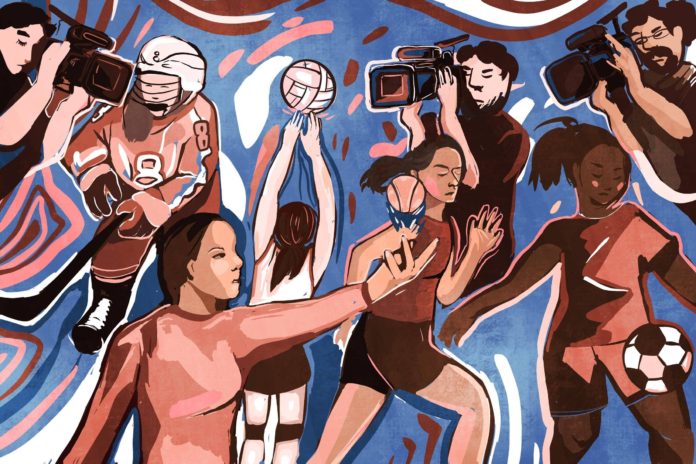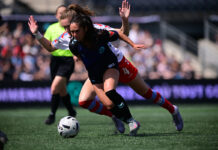The world of Canadian sports is filled with barriers and challenges that prevent many women and girls from participating in sports although it has numerous benefits.
According to Canadian Women & Sports, an organization that seeks to increase gender equity in sports, lack of media coverage, underrepresentation of female leaders, pay inequity and negative stereotyping are some of the challenges women in sport face.
Media coverage for women’s sports
Yazmeen Jamieson, former soccer goalkeeper for Carleton University in Ottawa and a member of the Jamaican National Soccer Team, said in an email that women are not given equal media time.
“I have played in many international matches and my team has made history in many games, but nobody is aware of these things because they are not deemed important enough to be broadcasted on major sports media outlets,” says Jamieson.
Jamieson is not alone in her frustration over the lack of media coverage in women’s sports.
Zoe Totten-Coulter, a Carleton University rugby player, says she is upset knowing many women around the world don’t receive the coverage they deserve.
“It has definitely gotten better and there are more women being reported and highlighted, but it would be nice to see an equal amount for both men and women,” says Totten-Coulter.
A 2016 report by Canadian Women & Sports, showed that female sports make up four per cent of programming on major Canadian sports networks compared to 38 per cent for male sports.
Greer Gemin, the communications and administration co-ordinator for Canadian Women and sport, said the lack of women’s sports media coverage is about money.
“Media executives are more likely to prioritize properties that will make them money in their primetime slots and they often don’t see women’s sports as having the audience to support that profit,” says Gemin.
The report showed that a lack of media coverage about women successes, fewer visible role models for girls, lead to gender role conflicts and higher levels of female withdrawal from sports.
“When you underrepresent women in sport, young girls start to believe that sports are deemed for males because they don’t see many representations of themselves on a large and credible platform,” said Jamieson.
Underrepresentation of women in sport leadership
Katarina Lauch, a master’s student in women’s and gender studies at Carleton University, is a goalie in a men’s hockey league. She says she has experienced female underrepresentation in sports leadership.
“I’ve always been coached by male coaches. I think we are socialized into gender roles where women are not typically hockey players, especially hockey coaches,” said Lauch.
“Women are more likely to be questioned on their decisions in those types of positions where you have to be more authoritative, so it’s harder for women to be in that space. They’re just not respected as authority [figures].”
Canadian Women & Sport in their 2016 report found that 32 per cent of head coaches for women’s teams are female. That number falls to one per cent for female head coaches of men’s teams at Canadian post secondary institutions. For mixed sports teams, 18 percent of coaches are female.
However, more female representation was found in the leadership positions of sports organizations. According to another report released on female leadership at sport organizations in 2020, 28 per cent of board chairs are women and 42 per cent of CEOs are also women.
Canadian Women & Sports advocates for encouraging more women in leadership positions to achieve gender parity through mentorship and creation of opportunities for women to gain experience.
Lauch agrees with including more women in leadership positions.
“Including more female-identifying coaches in minor league hockey on men’s and women’s teams would make a huge difference. If we have young boys and girls looking up to female coaches, they’ll start to respect female authority at a younger age.”
Pay inequity in women’s sport
In 2018, the top 10 highest-paid female athletes earned a combined $105 million, according to Forbes. In contrast, three of the top-earning male athletes earned more than $105 million each. Additionally, no female athletes appear in the list of the 100 highest-paid athletes. In 2019, only one woman, Serena Williams made it to the list of highest paid athletes at 63rd position.
Helen Jefferson Lenskyj, professor emerita of sociology and equity studies at the University of Toronto, has written extensively on women’s pay equity in sports. She said a lack of media coverage and underrepresentation in leadership leads to pay inequity.
“Pay inequity can be attributed to less media interest leading to less corporate sponsorships and less money to go around for women,” says Lenskyj.
Female athletes are frustrated at not having the same opportunities as men to make a living playing sports. Jamieson and Totten-Coulter share in this frustration.
“Women should be getting paid the same amount as men when playing the same sport. We all put in our time to train on and off the field and we all dedicate our lives to the sport,” says Jamieson. “Male sports bring in more revenue, but then that brings us back into the argument that women’s sports are not as broadcasted.”
Totten-Coulter agrees.
“I think women should be paid the same as men. The amount of money an athlete is given should be based on their athleticism, not their gender,” she said.
Negative perceptions and stereotyping of females in sport
27 per cent of girls say they are treated worse because of their gender in sports, according to a 2018 poll by IPSOS surveying 1,203 teenage girls and boys.
One reason for this is because female athletes are prejudged to be weaker, slower and inadequate to male athletes, according to Canadian Women & Sort.
According to Forbes, earlier this year, the United States Soccer Federation, argued in a court lawsuit that the women’s team deserve less pay “because, among other reasons, men have more ability, strength and speed.”
“Women start off with guys assuming they’re not competent and they have to prove they are, whereas the males start off competent,” said Lauch.
“From the start, the guys weren’t trusting I could play. When I got there, I saw the warm-ups and the guys taking slap shots on the male goalie. Then when they shot at me, it was lightly and carefully. It took five or six games for me to win before they took slap shots at me.”
Lauryn Walker, a Carleton University rugby player, speaks of the inequity and judgment she has faced in the sporting world.
“My entire life as an athlete has been a fight. Being a female athlete, I was never given the same chances or the same opportunities as any male athlete I’ve ever known,” she says. “I was always rejected and doubted, not because I was unqualified, but because I was a girl.”
Improving the future for females in sport
Female participation in sport has many benefits, including overall health benefits, decreased risk of depression and anxiety, improved well-being, empowerment, and opportunities for leadership and achievement, according to Candian Women & Sport.
“I think it is important for anyone to join sports,” Totten-Coulter said. “Sport gives the sense of pride and passion towards something that every woman should get to experience. Sport teaches many valuable life lessons and builds character.”
While there has been progress in women’s sports, women have yet to reach the goal of gender parity.
“We need to see women being prioritized not only from a perspective of diversity reflected in improved numbers of women in leadership, but also through inclusion, which would see women empowered and equitably treated in leadership roles,” Gemin said.
“There also needs to be accountability built into funding frameworks so that diversity and inclusion are mandated in the strategic and operational plans of sport organizations.”
Canadian Women & Sport also calls for an increase in female media coverage and encouragement by supporting a diverse, welcoming, and fun sporting environment.
“At times it may seem like we aren’t getting anywhere, but we are making progress. Once upon a time, where we are today was just a dream in someone’s mind,” Walker said. “Don’t be afraid to do something just because someone else says you can’t, because you never know the impact it’ll have on you or the impact you could have on someone else.”
Graphic by Sara Mizanojehdehi.






